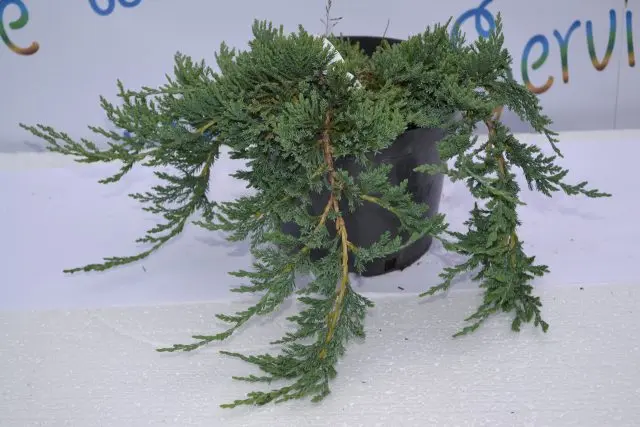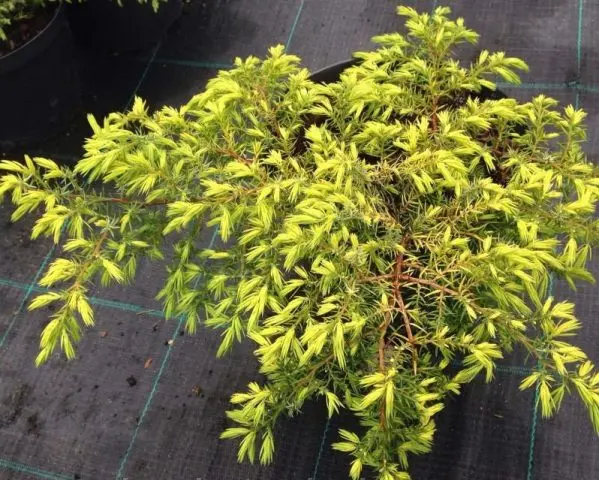Contents
In addition to outdoor evergreen trees of the cypress family, there is an indoor juniper that looks like them. At home, this beautiful low tree serves as an interior decoration and cleans the air from bacteria.

Is it possible to grow juniper at home in a pot
Junipers have a spectacular appearance, plastic shape, various colors. The plant is planted in summer cottages, in yards, in gardens. If you wish, you can grow juniper in the apartment. When planting a plant at home, this culture forms a low tree. In order for the plant to feel good in the home interior, it is necessary to choose the appropriate varieties. Undersized, slow growing varieties are ideal. Among the methods of reproduction are:
- seeds;
- cuttings.
The first method is more laborious and does not guarantee success, since seed germination is usually poor, and it takes several months from sowing to planting.
The second way is easier. In the spring, you need to cut a stalk 10 cm long from a tree that is at least 8 years old, place it in a mixture of peat and sand, cover and put in the shade. After 2 months, roots will appear, and then the plant should be transplanted.
Types of indoor juniper
Among conifers, few species can grow indoors. Juniper in the apartment room or in the winter garden feels good. Among the species that can be grown as houseplants, the following junipers are used:
- solid;
- Chinese;
- ordinary;
- horizontal.
Dwarf forms feel best at home, for example:
- Horizontal Wiltoni. It has blue needles, grows slowly, in adulthood it reaches 10 cm in height and 1 m in diameter. This species makes an excellent backdrop for other houseplants;

- Compress – as you can see in the photo, this is a room juniper of a columnar shape, miniature in size. It grows slowly: at the age of 10 years, the height of the plant is 60 cm;

- Common room Depressa Aurea – creeping view, height -30 cm, diameter 50 cm;

- Chinese Pyramidalis has a strict conical shape, blue-green needles, maximum height – 1,2 m;

- Medium – Old Gold, has scaly foliage that turns golden in autumn, suitable for bonsai formation.

Varieties of indoor junipers are also represented by larger, weeping and rocky specimens.
Features of growing juniper at home
Growing indoor juniper, you need:
- choose a large pot for freedom of the root system;
- make drainage from broken bricks, expanded clay, gravel, sand;
- do not allow the soil to dry out;
- regularly drain excess water from the pan;
- humidify the air in the room where indoor juniper grows.
- choose a sunny cool place for the plant.
How to plant juniper at home
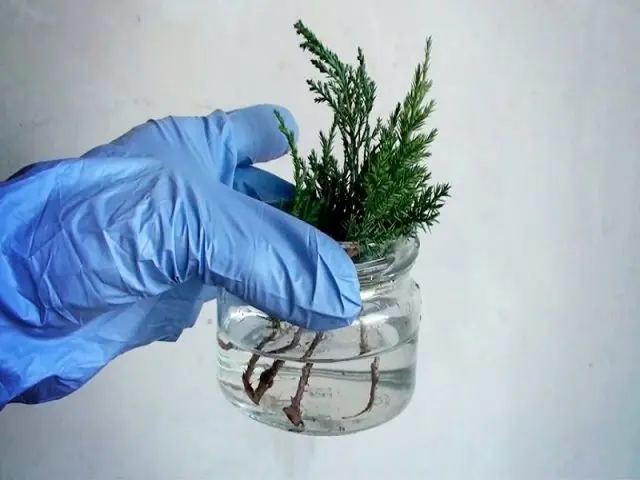
There are several ways to plant juniper at home. If there is a forest nearby, then in the fall you can find a young plant, carefully dig it out and, planting it in a pot of the appropriate size, bring it into the house. However, the disadvantage of this method will be difficulties in adapting the plant to new conditions, and in this case it becomes a real problem to keep the juniper in a pot until spring.
There is a planting option using cuttings. This method is more reliable and promising.
Planting material for the house can be obtained by layering, if you root a juniper branch right on the street. After the appearance of the roots, the branch is transplanted into a pot.
The easiest and most reliable way is to purchase the appropriate type of indoor juniper in a specialized store. In this case, it remains only to transplant the plant and take care of it according to all the rules.
How to root juniper at home
For propagation of indoor juniper by cuttings, it is necessary to prepare planting material:
- In the middle of spring, cut semi-woody shoots with a “heel”, 10 cm long, from the middle or upper part of the crown.
- Prepare a mixture of sand and peat.
- Moisten the substrate.
- Treat the planting material with a root formation stimulator.
- Place the cuttings in a container with the mixture.
- Pour the mixture with Kornevin’s solution.
- Cover the container with a film, take it to a shaded place.
- Carry out constant spraying of crowns.
- Two months later, after rooting the cuttings, transplant them into separate pots of the appropriate size.
What should be the soil for juniper in a pot
Despite the popular belief about the unpretentiousness of conifers, to grow juniper in an apartment, soil is needed that has the following properties:
- lightness and friability of the soil substrate;
- the impossibility of further compaction of the soil mixture;
- breathability;
- moisture content;
- ability to retain moisture;
Soil composition includes:
- sod land – 1 part;
- leaf humus – 2 parts;
- peat – 1 part;
- sand – 1 part;
- coniferous litter – 1 part.
You can purchase ready-made soil for indoor juniper in a specialized store.
Preparation of planting container and material
A large pot is suitable as a container for planting indoor juniper. In it, the root system feels comfortable. The soil in such a container remains porous, easily permeable to air and water. Moisture is evenly distributed throughout the volume, which facilitates the care of the ephedra.
The most suitable container material for planting indoor juniper is ceramics, clay and porcelain. Natural materials exclude the entry of harmful substances into the soil. By choosing the shape, design, pattern of the planter, you can emphasize the beauty of the plant. The advantage of clay pots is that moisture can evaporate through their surface. Due to the porosity of the material, the root system can be saturated with oxygen. The roots of indoor juniper are warm in a pot in winter, and cool in the heat.
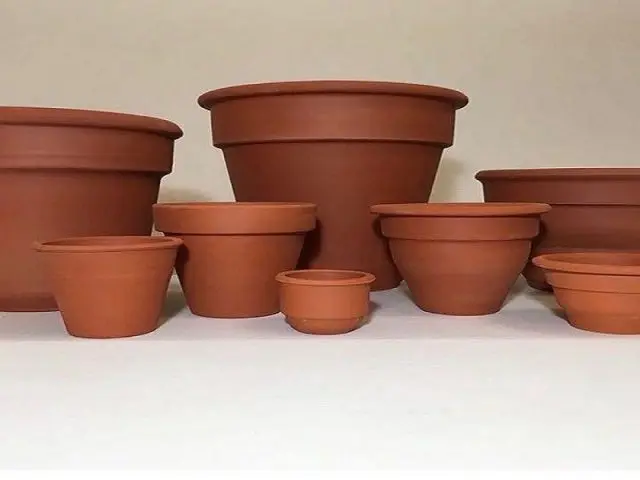
The disadvantages of ceramics include:
- fragility with careless care;
- the roots of the plant can stick to the surface and be injured during further transplantation.
To prepare new clay pots for planting, they must be immersed in water for 2 hours. During this time, gases and harmful substances formed during firing are removed from the pores. A container that has already been in use should be washed with soap and a brush, boiled with soda, rinsed with running water.
How to plant a juniper in a pot
To plant an acquired seedling or a rooted cutting of indoor decorative juniper, you must:
- Pick up a pot, the volume of which should significantly exceed the size of the earthen coma or container in which it was purchased.
- Provide drainage holes in the bottom of the container.
- Place drainage on the bottom (pebbles, small pebbles).
- Soak the plant together with the container in a large container with Kornevin dissolved in it.
- Wait until the container stops floating and sinks to the bottom.
- Pour the soil mixture prepared in advance on top of the drainage by 4 – 5 cm.
- Carefully remove the juniper from the container, shaking it and squeezing the walls.
- Set the plant vertically in a pot below its edge by 3 cm.
- Fill voids with soil substrate.
- Tamp the soil a little.
- Water.
- Place in a cool bright place without direct sunlight and drafts.
- If necessary – shade.
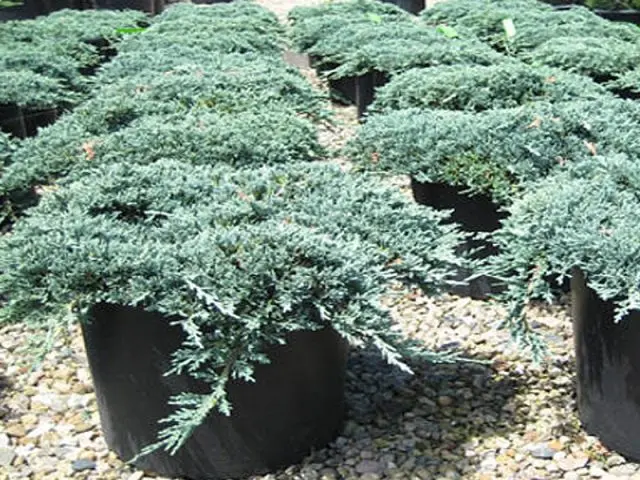
juniper transplant
Unlike many domestic flowers, indoor juniper should be subjected to an annual transplant procedure. The best time will be mid-March. The height of the plant should not exceed 1 m. To transplant, you must:
- Prepare a pot, 1,5 – 2 times larger than the previous one, soil and material for drainage.
- Carefully separate the soil from the walls with a spatula, being careful not to damage either the roots or the pot.
- Remove, holding at the base with a large clod of earth and place in a new container, in a previously prepared recess in the ground.
- Fill the voids formed, tamp a little, mulch the soil surface with peat or bark.
The level of the juniper above the ground should remain the same. Do not bury or plant above the transplanted houseplant.
It is necessary to water the plant abundantly, with warm, settled water. After transplantation, more comfortable conditions should be created so that the engraftment process is painless. You can take the juniper to the balcony, shading it if it gets direct sunlight, the optimum air temperature is +18 ⁰С. It is not bad to carry out daily spraying of juniper crowns with water. When the indoor coniferous plant reaches its maximum growth and becomes an adult, transplants can be stopped, but periodically it will be necessary to add fertile soil to the pots.
How to care for juniper in a pot
The conditions for keeping conifers are almost the same for all species. They should be located on the north or northeast side of the house and at the same time shade from sunlight. The plant reacts negatively to “moving”, it is worth refraining from changing the place of residence of indoor juniper. Otherwise, the conifer must adapt to new conditions, its normal development is inhibited. In the summer, it is useful to take out a decorative juniper in a pot outside, in partial shade.
In winter – to provide conditions under which the houseplant will be further from the heating system. The best place for wintering is a warm loggia or window sill, where it is cool. The optimum temperature will be in the range from 6 to 12 ⁰С. If there is no suitable place, then the conifer can be protected from hot air and drying out with a plastic film. At the same time, maintain air access, but remember that winter is a real test for a houseplant, so you should help him overcome this period.
Optimal temperature, humidity and lighting
If you decide to plant a juniper at home in a pot, caring for it requires the creation of certain climatic conditions. In summer, it is impossible to allow ambient temperatures above 25⁰С and cooling below 12⁰С. The plant loves fresh air, but does not tolerate drafts. In the heat, it is worth taking it outside and carrying out daily spraying to maintain moisture and clean foliage or needles from dust.
The plant needs bright light, but the lighting should be diffused. Direct sunlight can cause burns. Pots with indoor plants taken outside in the summer should not be constantly in the shade.
How to water juniper at home
In summer, in hot weather, plants require abundant watering. The state of the earthen coma should be monitored. Both waterlogging and drying out of the soil are harmful. For watering indoor juniper, clean, warm, settled water is used. The frequency of the procedure is 1 time in two days.
By autumn, watering is gradually reduced. If the air temperature has already dropped and the room is not yet heated, humidification should be very careful, especially in inclement rainy weather, when air humidity rises and the soil dries out slowly.
In winter, the air in the apartment is dry, the humidity is low, evaporation is fast. Watering should be carried out 2 times a month, but at the same time monitor the drying of the topsoil.
In the spring, the dose of moisture should be increased again.
The crown must be sprayed with warm, settled water regularly, throughout the year – twice a day in summer and every other day – in winter.
How to feed juniper home
For juniper growing in a pot, care at home also consists in its periodic feeding. The ephedra, which is in the phase of active growth (from April to September), should receive mineral fertilizer once every two weeks when watering. It is used according to the instructions. Indoor juniper is in great need of feeding, because it does not receive nutrients from the outside. With the onset of autumn, top dressing is reduced and adjusted to once a month. From December, fertilization is stopped until spring.
As a fertilizer, you can use humus added to the plant pot. The interval between organic and mineral top dressing should be at least two weeks.
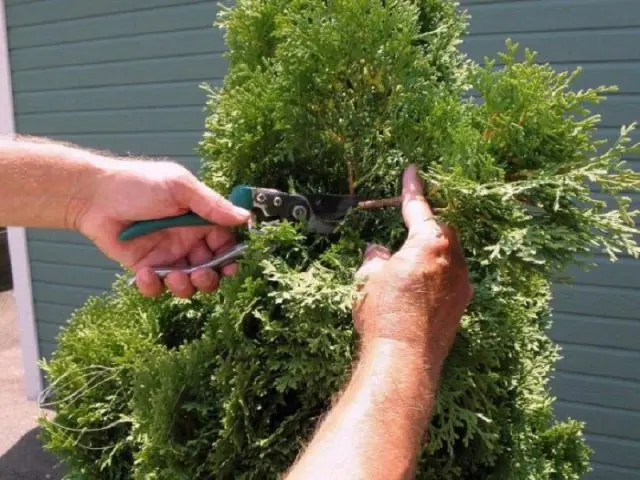
Trimming and shaping
To give the indoor juniper an elegant shape, it is pruned once a year for sanitary purposes. The best time for this is February. The growth of conifers is slow, but at the end of winter it accelerates. At this time, dried or deformed branches should be removed. It is recommended to cut off a little young shoots and a little more – the top of the plant. This pruning technique allows you to achieve the splendor and attractiveness of indoor juniper, as well as strengthen its health.
Coniferous species, designed according to the canons of Japanese bonsai art, look quite original. The process is long, complex, requires patience and knowledge of how to properly form and cut a tree, from which a small masterpiece is obtained.
Diseases of indoor juniper
A houseplant is prone to fungal diseases and pests.
- brown mold most often affects the young branches of indoor juniper in hot and rainy summer weather. For the purpose of prevention, it is necessary to thin out diseased damaged branches more often.
- Rust infects needles, shoots die off. For treatment, diseased parts are cut out, treated with immunostimulants, fungicides, and Bordeaux mixture. Cut parts of the affected plant should be destroyed.

Indoor juniper pests include:
- scabbard – affects the needles, the branches of the plant dry out;
- sawfly – eats away tissue from the inside;
- moth caterpillars – eat young branches.
Pests can be controlled by spraying insecticides.
What to do if the juniper dries out at home
There are several reasons for yellowing and drying of indoor juniper branches:
- lack of nutrients;
- excessive dryness or moisture of the soil;
- lack of proper drainage;
- the introduction of fungi or pests.
After determining the reason why the home juniper dries, it is necessary to take the necessary measures – treat with pesticides, reduce or increase watering, change the soil substrate, make drainage and transplant the plant or carry out its full feeding.

Conclusion
Unlike outdoor species, indoor juniper is constantly in the house next to people. Its presence creates coziness, and coniferous aroma contributes to healing, air purification, strengthening sleep. Dwarf species in the home interior give aesthetic pleasure. It is necessary to know and remember all the nuances of growing and caring for indoor juniper so that it develops correctly and quickly.










